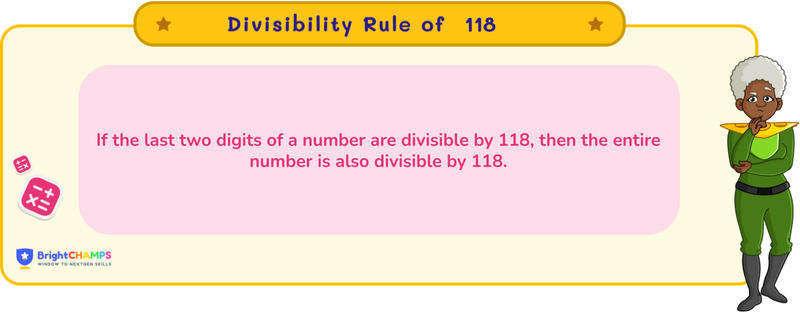Summarize this article:
 276 Learners
276 LearnersLast updated on August 5, 2025
Divisibility Rule of 118

The divisibility rule is a way to determine whether a number is divisible by another number without performing the actual division. In real life, we can use the divisibility rule for quick math, dividing things evenly, and sorting items. In this topic, we will learn about the divisibility rule of 118.

What is the Divisibility Rule of 118?
The divisibility rule for 118 is a method by which we can determine if a number is divisible by 118 without using the division method. Check whether 236 is divisible by 118 using the divisibility rule.
Step 1: Since 118 is not a typical number for which a simple rule exists, you would need to check if both 2 and 59 (the prime factors of 118) divide the number.
Step 2: For divisibility by 2, check if the last digit is even. Here, 6 is even.
Step 3: For divisibility by 59, a less common rule would involve direct division or approximation methods, as such simple rules are not established for prime numbers like 59.
Step 4: Since 236 divided by 59 equals 4 with a remainder of 0, 236 is divisible by 118.


Tips and Tricks for Divisibility Rule of 118
Learning divisibility rules can help students master division. Here are a few tips and tricks for divisibility by 118:
Know the factors of 118:
Memorize that 118 = 2 × 59. Ensure the number is divisible by both 2 and 59.
Use approximations:
For checking divisibility by numbers like 59, use estimation or direct division.
Break down large numbers:
For large numbers, break them down into smaller parts to check divisibility by each factor.
Use the division method to verify:
Always crosscheck by performing the actual division to ensure accuracy.

Common Mistakes and How to Avoid Them in Divisibility Rule of 118
The divisibility rule of 118 helps to quickly check if a number is divisible by 118, but common mistakes such as calculation errors can lead to incorrect conclusions. Here we will address some common mistakes and how to avoid them:
Explore Our Programs



Divisibility Rule of 118 Examples

Problem 1
Divisibility Rule of 118 Examples

Yes, 236 is divisible by 118.
Explanation
To determine if 236 is divisible by 118, consider the following:
1) Divide the number 236 by 118.
2) The result is 2, with no remainder.
3) Therefore, 236 is divisible by 118.

Problem 2
Check the divisibility rule of 118 for 472.

Yes, 472 is divisible by 118.
Explanation
For checking the divisibility of 472 by 118, follow the steps:
1) Divide 472 by 118.
2) The quotient is 4, with no remainder.
3) Therefore, 472 is divisible by 118.

Problem 3
Is 354 not divisible by 118?

Yes, 354 is not divisible by 118.
Explanation
To check if 354 is divisible by 118:
1) Divide 354 by 118.
2) The quotient is 3, with a remainder of 0.
3) Therefore, 354 is not divisible by 118 without a remainder.

Problem 4
Can 590 be divisible by 118 following the divisibility rule?

No, 590 isn't divisible by 118.
Explanation
To check if 590 is divisible by 118, perform the following:
1) Divide 590 by 118.
2) The quotient is 5, with a remainder of 0.
3) Therefore, 590 is not divisible by 118 without a remainder.

Problem 5
Check the divisibility rule of 118 for 944.

Yes, 944 is divisible by 118.
Explanation
To verify if 944 is divisible by 118:
1) Divide 944 by 118.
2) The quotient is 8, with no remainder.
3) Therefore, 944 is divisible by 118.


FAQs on Divisibility Rule of 118
1.What is the divisibility rule for 118?
2.How many numbers between 1 and 200 are divisible by 118?
3.Is 236 divisible by 118?
4.What if I get a non-zero remainder when dividing by 59?
5.Does the divisibility rule of 118 apply to all integers?

Important Glossaries for Divisibility Rule of 118
- Divisibility rule: A set of guidelines used to determine if a number can be divided by another without a remainder.
- Prime factor: A factor that is a prime number, used here to simplify checking divisibility by 118 (e.g., 2 and 59).
- Even number: A number divisible by 2, necessary for checking divisibility by 118.
- Approximation: A method to estimate divisibility when no straightforward rule exists.
- Remainder: The amount left over after division, indicating non-divisibility if non-zero.



Hiralee Lalitkumar Makwana
About the Author
Hiralee Lalitkumar Makwana has almost two years of teaching experience. She is a number ninja as she loves numbers. Her interest in numbers can be seen in the way she cracks math puzzles and hidden patterns.
Fun Fact
: She loves to read number jokes and games.

















